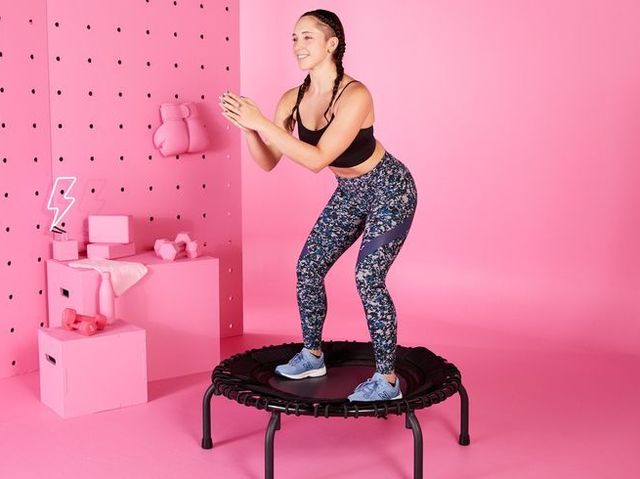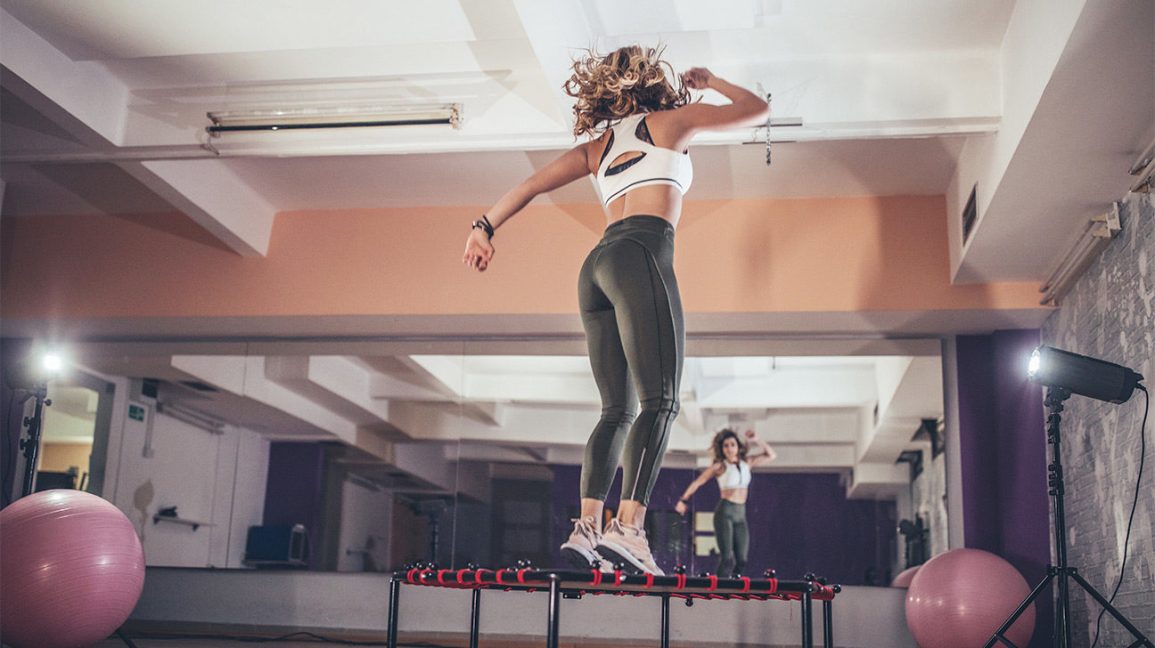You can’t beat a tiny trampoline for channeling your inner child. Mini trampolines are a fun way to get your heart racing and your muscles moving, which may help you lose weight, enhance your heart health, and improve your muscular strength and coordination. However, like with any exercise, too much mini trampolining can be harmful to your health, so consult your doctor about the best training program for you.
Mini-trampoline courses, commonly known as “rebounding,” have recently gained popularity. On his own trampoline, each student jumps and sprints in place during class, frequently to music. According to physical therapist Scott Euype, education director at Cleveland Clinic’s Rehabilitation & Sports Therapy, “fans claim these fast-paced workouts scorch calories and develop muscles with less stress than on a hard surface.”
However, before jumping on this bandwagon, you should exercise caution. If you leap too high or too rapidly, you risk injuring a joint that is already inflammatory or injured. Plus, according to Mary Ann Wilmarth, owner of Back2Back Physical Therapy in Andover, Massachusetts, and a representative for the American Physical Therapy Association, “the landing surface is unstable, so you might turn an ankle or injure your knee.” Before you start rebounding, see your doctor. (Unless your doctor has given you permission, avoid it if you’ve undergone joint replacement in your feet, ankles, knees, or hips.)
You might be able to gradually work up to leap with the help of a physical therapist. Begin by walking for a few minutes on the trampoline. You may gradually go to stepping side to side, jogging in place, and finally lightly bouncing. “Wear shoes that aren’t too stiff,” Wilmarth advises, so you can feel the movement.
A mini-trampoline can also help you improve your balance. Try standing with your feet together and your eyes closed, one foot slightly ahead of the other, pulling each knee toward your chest slowly while standing, and kicking each leg to the side while standing.
Is Trampolining Good For Joints?
Jumping can cause joint damage because it requires your knees, hips, and ankles to carry your body weight repeatedly when you land. Some physicians prescribe trampoline jumping to patients with joint issues since it helps to reduce impact. Excessive leaping, however, such as jumping past the point of pain or for longer than your doctor recommends, can harm your joints, especially if you have chronic joint issues like osteoarthritis. As you become older, repetitive motions can weaken your joints, which can lead to fractured bones if you fall.
Is Jumping On A Trampoline Good For Your Muscles And Bones?
Excessive trampolining, like any other form of exercise, can put a strain on your muscles. After a few days, overuse injuries usually heal on their own. However, if you try to be creative and hop on one foot or do stunts, you risk losing your balance or misproportioning your weight. This can result in more significant strains and sprains, putting you out of commission for weeks or even months. While regular exercise can help strengthen your bones and prevent osteoporosis, stumbling due to negligent or excessive leaping might result in a bone fracture.
Why Is Jumping On A Trampoline Good For You?
Because the trampoline rebounder softens the return better than solid ground, trampoline jumping combines vertical leaping with a low-impact landing. The vertical leap is an excellent workout for developing muscles throughout the body, and using a trampoline to soften the impact allows you to perform more, jump higher, and for longer.
Health Benefits of Jumping On The Mini Trampoline
Because you’re not raised several feet off the ground, and there’s not enough area to execute hazardous feats like flips, tiny trampolines provide a lower risk of head injury than full-sized trampolines. Trampolines can help you improve your balance and develop your lower body. They also provide good cardiovascular exercise, which can aid in calorie loss and the development of the desired body.
What’s So Good About The Vertical Jump?
The vertical leap is a plyometric exercise that targets the lower body’s major muscle groups. It’s quick, forceful, and easy to execute. Jumping causes an increase in heart rate, which improves cardiovascular function.
What Muscles do You Use Jumping on a Trampoline?
A leap is made up of numerous motions, each of which has its own link to your body’s muscles.
Extension Of The Hips
Assume you’re seated in a chair and then rise. A hip extension is a movement that moves you from sitting to standing. Before your feet ever leave the mat/ground, it is the initial part of the leap. It primarily works the muscles of the upper leg, such as:
- Gluteus maximus
- Adductor Magnus
You engage these muscles and strengthen their function with each leap.
Knee Extension
Knee extension is the straightening of the leg at the knee joint, which is done practically concurrently with hip extension. The quadriceps is the most commonly utilized muscle during knee extension.
Ankle Plantarflexion
‘Point your toes’ is the final body action before leaving the mat. Ankle plantarflexion is a movement that predominantly involves the calf muscle.
Shoulder Abduction And Flexion
Jumping is a fantastic workout for strengthening the lower body on its own. You may increase the intensity of your trampoline leaps by using arm motions.
Which Muscles Do You Engage Jumping On A Trampoline?
When jumping on the trampoline is generally a full-body workout, there are a few muscle groups that receive extra attention while doing so.
Your quadriceps will be strengthened by jumping on a trampoline. The quadriceps are a group of four muscles that go along the front of your thighs:
- Vastus medialis
- Vastus lateralis
- Rectus femoris
- Vastus intermedius
The jumping movement on a trampoline combines hip flexion and knee extension, both of which strengthen your hamstrings.
Bouncing On A Trampoline Will Also Help To Strengthen Your Hamstrings
The hamstrings, which are located at the rear of your thighs, have a similar but opposing role to the quadriceps. The hamstrings are made up of three parts:
- Biceps femoris
- Semitendinosus
- Semimembranosus
During the descending and explosive stages of the leap, all three components are stimulated via hip extension and knee flexion.
Building Calf Strength Through Repetitive Bouncing
Calf strength may be improved by doing kick, repetitive bouncing on the trampoline, similar to what you would do with a jump rope. Your calves are made up of two sections that are positioned at the rear of your leg between the knee and the ankle:
- Gastrocnemius
- Soleus
Both are stimulated during rapid leaping, and tuck leaps on the trampoline are another great way to strengthen your calves.
Strengthening Your Core With Trampoline Bouncing
When you bounce on a trampoline, you’re also working your core muscles in the area of your spine and abdomen. Stability, balance, and posture all require a strong ‘core.’
Trampoline bouncing, unlike many other workouts, is low impact, with the trampoline mat dispersing much of the impact energy on the return bounce.
Abdominals
Strong abs generally entail hours of crunches each week, which may be taxing on your back and, let’s face it, isn’t really enjoyable. Jumping up and down on a trampoline rebounder mat, on the other hand, could be just as effective. Your abdominals flex as you travel up and down, providing a low-impact exercise that’s also enjoyable.
Back and Shoulders
So much of life’s stress accumulates in our backs and shoulders. These are delicate regions, and strengthening them without causing harm can be difficult. Even a brief session on a trampoline mat, on the other hand, may engage the muscles surrounding your spine and shoulder blades, strengthening your back muscles without putting undue strain on your body.

